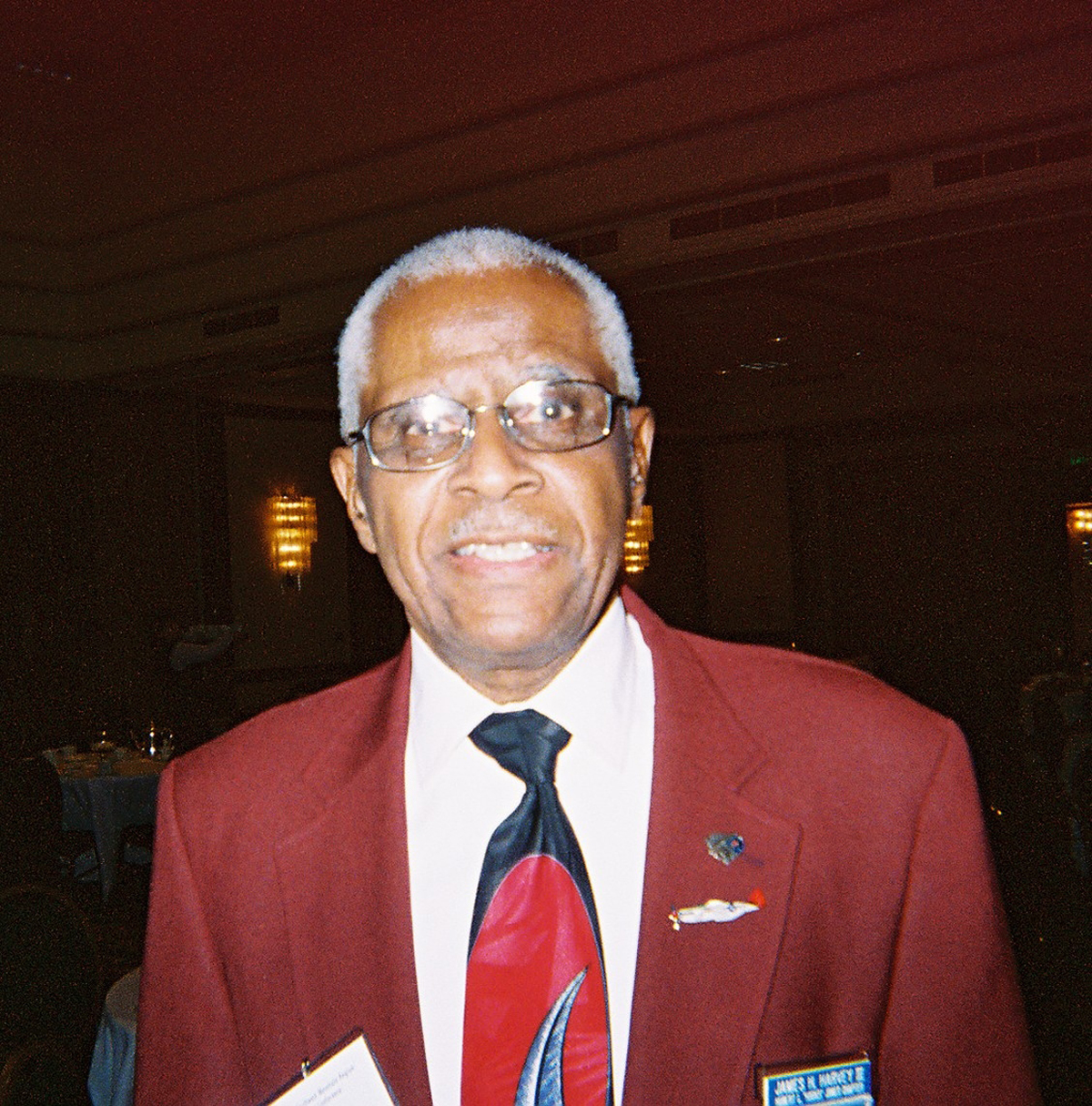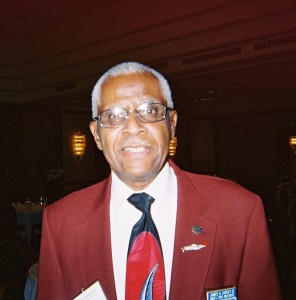By Jennifer Iversen
Tuskegee Airmen Lt. Col. James Harvey III wanted to fly from the time he was a young boy.
“One day I looked up and saw a flight of P-40s and said, ‘I’d like to do that some day,'” he recalled. “That was all; I forgot about it.”
Born and raised the oldest of four children in Mountain Top, Penn., Harvey would later try to enlist in the Army Air Corps. But he received a letter saying, “We’re not taking enlistments at this time.”
“That was wrong,” he said. “That was during high time in the war. Then, they drafted me into the Army in April 1943.”
Harvey shared his memories as a luncheon guest speaker during the 2005 FAA Northwest Mountain Region Airport Conference. He said that after taking a series of complex military entrance tests, he was placed in the Army Air Corps as an engineer. He performed his duties, but said, “This isn’t for me.”
“So I applied for cadet training again, and this time I was accepted,” he said.
After basic training in Mississippi, he went on to Tuskegee, Ala., the site of a U.S. military experiment. The participants of the Tuskegee Experiment were the first black men to become military airmen.
Harvey said at that time America was full of stereotypes against African-Americans. He added that the Army War College Studies, which were unscientific surveys and interviews with white officers who commanded African-American troops during WWI, perpetuated the stereotypes.
“According to the studies, Negro troops were childlike, careless, irresponsible, secretive, superstitious, unmoral and untruthful,” he said. “Now how would you like to have that hanging over your head?”
The Tuskegee Experiment had obstacles built in to make it inevitable for the airmen to fail. The first obstacle was the airfield at which they would train. At that time, said Harvey, Tuskegee was “one of the worst places in the country for us as a people.”
There was one clear solution to avoid being victims of the violent behaviors that took place in town.
“We stayed on the post,” said Harvey. “If you don’t subject yourself to that kind of stuff nothing happens.”
The second obstacle was that the War Department specified that the airfield be built in nine months.
“That’s the runways, the taxiways, the ramp, the hangars and all the buildings necessary to house the personnel,” said Harvey.
He said the third obstacle was that the men would be placed in pursuit squadrons, which he said would require “the most demanding flying there is.”
Determined to succeed, the airmen evaluated each obstacle and discovered ways around them. Contract workers hired to build Tuskegee Army Air Field (TAAF) completed their construction within the nine months allotted to them.
Harvey said the third obstacle was conquered by learning and mastering “navigation, gunnery and acrobatics.”
The first aviation cadet class began in July 1941. Training was completed nine months later. Out of the 13 who started in the first class, five successfully completed the training, including Capt. Benjamin O. Davis Jr., a West Point Academy graduate.
From 1942 through 1946, 992 pilots graduated at TAAF; of those, 450 served overseas in either the 99th Pursuit Squadron (later the 99th Fighter Squadron) or the 332nd Fighter Group.
Harvey said that the pilot failure rate amongst the white pilots at that time was 63 percent, while the failure rate of the Tuskegee pilots was only 40 percent. Due to those statistics, he said, the military changed the training of the Tuskegee Airmen, which raised the failure rate to 70 percent.
“Our training was more demanding, because they were trying to wash us out,” he said.
“When it came time to go overseas during World War II, Harvey said that normally troops were sent in a convoy of ships, with a Navy escort. However, when the 99th Fighter Squadron went overseas, with all of their crewmen and medical and administrative personnel, they were on a single ship from Norfolk, Va. to Africa. At the time, the Germans controlled the Atlantic with their submarines, and their intelligence was very good.
“They probably knew that the 99th and all of their people were on that ship, but based on what they had heard from white America, they said, ‘They’re no threat,'” Harvey said.
The 99th Fighter Squadron would fly P-40 Warhawks in combat in North Africa, Sicily and Italy from April 1943 until July 1944. At that time, the 99th FS was transferred to the 332nd Fighter Group in the 15th Air Force.
While based in Africa, the 99th FS shared the base with one other P-40 outfit. Harvey said one of the commanders from the other outfit sent a damaging message to Washington, D.C.
“It said the 99th couldn’t find their targets…their attitude was poor, and their morale was poor,” he said. “That letter would climb through the ranks of command; more commanders would tag on their two cents, and all of it was negative.”
Davis went back to Washington to rebuttal the report. After he expressed the true intelligence, skill, mannerism and morale of these airmen, the 99th FS and the 332nd FG were granted the mission to escort bombers.
Originally, the 332nd FG consisted of the 100th, 301st and 302nd fighter squadrons. After training in P-40 Warhawks and P-39 Airacobras, the group began overseas combat operations near Naples, Italy, in February 1944, with the 12th Air Force, flying air patrols over Naples Harbor and the Mediterranean Sea.
In April 1944, the 332nd FG’s “red tail” fighters began conducting long-range heavy bomber escort missions for the 15th Strategic Air Force. In July 1944, the 99th FS became the only four-squadron fighter group performing bomber escort missions in the 15th Air Force.
The Tuskegee Airmen would establish the unprecedented record of flying all of its bomber escort missions—200 over most of central and southern Europe—without losing a single bomber to enemy aircraft.
The 99th FS received two Presidential Unit Citations for outstanding tactical air support and aerial combat, while in the 12th Air Force before joining the 332nd FG. The 332nd FG received the Presidential Unit Citation for its longest bomber escort mission to Berlin, Germany, on March 24, 1945. They destroyed three German ME-262 jet fighters and damaged five additional jet fighters without losing any of the bombers or any of its own fighter aircraft to enemy aircraft.
The 332nd FG also distinguished themselves in June 1944, when two of its pilots flying P-47 Thunderbolts discovered a German destroyer in the harbor at Trieste, Italy. Using only the aircraft’s 50-caliber machine guns, one of the pilots strafed the destroyer, causing it to explode and sink.
The newly formed U.S. Air Force initiated plans to integrate its units as early as 1947. In 1948, President Harry Truman enacted Executive Order Number 9981, which directed equality of treatment and opportunity in all of the U.S. armed forces. This order, in time, led to the end of racial segregation in the military forces.
In 1949, pilots from the 332nd FG participated in the Air Force National Fighter Gunnery Meet at Las Vegas Air Force Base, Nevada. Harvey said that when the 332nd landed in Las Vegas, the other airmen laughed at them.
“We were the only airmen at the meet who flew in P-47s,” Harvey recalled. “Our competition was flying P-82s and P-51s.”
He said the second reason they were laughing was because of their color. But the laughter didn’t continue, because the pilots from the 332nd FG won the meet that year.
The winners of the annual meet are traditionally announced in the yearly almanac put out by the USAF. But that year, they weren’t.
“It was stated that the winners were unknown,” Harvey said.
In fact, it remained unknown who won the 1949 Weapons Meet until 1995.
“It wasn’t that the winners weren’t known,” he said. “It was that the Air Force didn’t want to recognize the accomplishment of these men. The trophy was also ‘lost’ and not granted to the winners until 56 years after the meet.”
Harvey went on to fly in a jet squadron. He trained in an AT-6 before attending ground school for the F-80. He flew 126 missions in the F-80 during the Korean War.
Since the beginning of Harvey’s flight training, the list of aircrafts he’s flown is long. They include the PT-17, BT-13, A-26, P-40, P-47, P-51, F-80, F-86, F-89, F-94 and the F-102.
“The one I like the best was the F-102, which was the fastest thing that I have ever flown,” he said.
In May 1965, Lt. Col. Harvey retired from the military. His decorations and awards were many, including the Distinguished Flying Cross, Air Medal with 10 Oak Leaf Clusters, Distinguished Unit Citation with 10 Oak Leaf Clusters, World War II Victory Medal, Korean Service Medal with 2 Bronze Stars, Republic of Korea Presidential Unit Citation and the United Nations Service Medal.
Harvey, who says everything in life is an attitude, says he personally didn’t have any hardships as a Tuskegee Airman. He adds that he succeeded in many areas in his life because he focused on what he had control over instead of what other people did, said or thought.
“The way I looked at it, I didn’t have the problem; they had the problem,” he said. “So I was all right! Everything was fine with me. Maybe my head was in the sand. I don’t know, but that’s the way I looked at it.”
Civilian life
Following retirement from the military, Harvey went to work for Oscar Mayer, after applying at the home office in Madison, Wis.
After training in Madison, he moved to New Jersey to work as a salesman. After three years, he was promoted to district manager in Detroit, Mich., at a distribution center. He stayed there for 18 months and was then transferred to Philadelphia as an assistant sales manager. After three years, he was sent to Denver as a distribution center manager. In that position, he was responsible for a four-state region.
The company’s first black distribution center manager, Harvey remained in that position in Denver until February 1980, when he retired from Oscar Mayer.
“I had a good job,” he said. “I loved it!”
In his free time, when he’s not traveling, Harvey enjoys talking to today’s youth about education and pursuing opportunities within the field of aviation. He’s not the only Tuskegee Airman that devotes his time to that cause.
The Tuskegee Airmen, Inc. was formed in 1975. The charitable, inspirational and educational organization gives merit-based national scholarships to high school graduates.
“There are 46 scholarships a year now,” Harvey said.
The funds given so far are valued at $1.7 million, with $60,000 of awards being presented each year.
The organization, with a membership of over 2,000 in 44 chapters, is on a mission “to inspire young people to outstanding achievement and leadership in our democratic society though social and educational activities.”
“We try to get kids interested in aviation, but if not, just in going to college,” Harvey said.
To achieve this objective, members promote success within education, inspiring youth to study and to pursue skills in the related fields of aviation and aerospace.

This mural honoring the Tuskegee Airmen hangs at Los Angeles International Airport on the lower/arrival level of terminal three.












